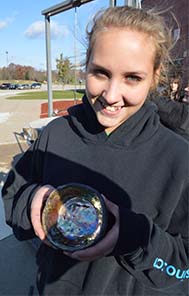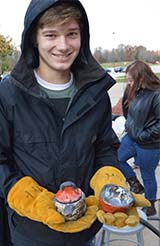The late-autumn air is frigid, but inside the kiln it’s almost 2,000 degrees.
Lowell High School students gather around the shiny metal cylinder as art teacher Susan Langford shouts, “Our kiln is almost ready!” Student Tanner Barnes cranks a winch to open the kiln, revealing a dozen red-hot ceramic bowls within.
Chemistry teacher Tammy Coleman roots them on: “Let’s roll, tongs people!” Her tongs-wielding students carefully pluck the bowls out of the kiln and gingerly deposit them in trash buckets filled with wood chips, leaves and straw. Flames leap up. Other students blanket the smoking cauldrons with wet newspaper and set lids on top.
with wood chips, leaves and straw. Flames leap up. Other students blanket the smoking cauldrons with wet newspaper and set lids on top.
About 20 smoldering minutes later, students extract the bowls and hose them off in the grass, where they gleam with a rich metallic glaze.
So goes the magic of raku, an ancient Japanese pottery form that Lowell art and chemistry students recently created in a collaboration of science and the arts. “It’s kind of cool how you can combine chemistry and art and make something beautiful,” says chemistry student Mitch Clay.
Tanner, who is taking both chemistry and ceramics classes, said understanding the chemical reactions complements the aesthetics of raku. “I learn about it in chemistry, and I can apply it to ceramics,” he says.
 Creatively Mixing Disciplines
Creatively Mixing Disciplines
The collaboration of chemistry and advanced ceramics students emerged from a grant to connect different learning areas. Langford taught Coleman’s chemistry students about the centuries-old art of raku, while Coleman taught Langford’s art students about the chemical changes that create raku’s distinctive multicolored glazes.
“Science isn’t just science, and art isn’t just art,” says Langford, who has taught raku for several years. “They’re vastly interconnected.”
The cooperative project reflects the spirit of raku, which traditionally was used in tea ceremonies to symbolize unity among diverse people, she adds.
Unlike normal pottery, raku pieces are created in preheated kilns, quickly fired, then placed in closed containers filled with combustible natural materials. The smoldering flame reduces oxygen and produces a shiny glaze with unpredictable colors. “It’s kind of a mystery what our glaze is going to look like,” Coleman says. “That’s the magic of raku.”
Chemistry and ceramics students alike enjoy the mystery. “You don’t know exactly how it’s going to look,” says senior Aubreigh Steed. “It’s more of a surprise.”
 “I like to see how it turns out with all the shiny, metallic colors,” adds junior Alainie Thomas, who’s interested in both pharmacy and art. “It’s something new.”
“I like to see how it turns out with all the shiny, metallic colors,” adds junior Alainie Thomas, who’s interested in both pharmacy and art. “It’s something new.”
CONNECT








